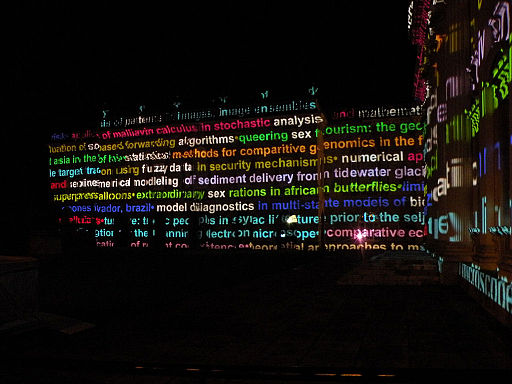Category: Communication
RDR on 10 Distinctive Qualities of Qualitative Research
Research Design Review recently summarized 10 distinctive qualities of qualitative research which succinctly capture the essence and utility of the kind of work performed by researchers like me.
In her Research Design Review piece, author Margaret Roller observes that qualitative research happens because researchers “acknowledge the human condition and want to learn more, and think differently, about a research issue than what is usual from mostly numerical quantitative survey research data.”
Below are Roller’s 10 attributes (in bold) and the reasons I consider them useful.
- Absence of “truth”
- As suggested on this blog regularly, knowledge is constructed from information and in context. It is the the product of the process of research; it is not truth but rather “possibility” (plausible interpretation). I often describe my findings or interpretations as “ONE truth” or “one version of truth/reality,” emphasizing that my interpretation is well-informed but always subject to negotiation based on further context
- Importance of context
- The setting, culture, research parameters and questions always influence the ways in which we can interpret data.
- Importance of meaning
- Meaning is created through understanding the blooms from the intersections of many points in analysis. Roller suggests sources for meaning include “any number of variables such as: the context, the language, the impact of the participant-researcher relationship, the potential for participant bias, and the potential for researcher bias.”
- Researcher-as-instrument
- The interpretations and the process of research are performed through and organized by and described through the researcher. This has many benefits including the potential for nuanced findings and “thick description” but it is also important to consider the bias, approaches, and institutional contexts of the researcher – as well as the power the researcher wields as an instrument of qualitative analysis. Remember, many choices, and therefore the exercise of power, play a role in final interpretations.
- Participant-researcher relationship
- This is element of qualitative research is extremely important in performing and getting useful and accurate interpretations. Communication, rapport, and accountability all play a role in a successful participant-researcher relationship and shape the outcomes of data collection and analysis.
- Skill set required of the researcher
- Perhaps the most underrated of these qualities, qualitative research “requires a unique set of skills from the researcher, skills that go beyond the usual qualities of organization, attention to detail, and analytical abilities that are necessary for all researchers,” Roller observes. She goes on to list rapport-building and active listening as further examples, but her most notable point is that specific and nuanced analytical toolkit is necessary to “meet the demands of “messy analysis” (see below) in qualitative inquiry where context, social interaction, and numerous other inter-connected variables contribute to the realities researchers take away from the field.” This is often the most difficult thing to explain when entering a project but often unfolds without stakeholders realizing. If it’s a smooth researching process with audiences, you’ve likely brought on board a skilled researcher.
- Flexibility of the research design
- Again, an extremely complicated skill to bullet point on a resume. Yet, a flexible researcher knows how to stay active and continue to derive communication while simultaneously analysing the information; second and third passes over the data will allow for even more robust findings. In other words, the intended questions may be set aside to capture the reality of the researching space and research may take iterations to flesh out hidden meanings and perspectives.
- Types of issues or questions effectively addressed by qualitative research
- Especially for questions that really mean “to what extent” rather than “how much” or seeking to understand group behaviors and cultural values that emerge concurrently with or contradict official/dominant perspectives.
- Messy analysis and inductive approach
- Qualitative research may start with a general question and create understanding as knowledge is being attained. Roller writes “without a doubt, qualitative research analysis is messy. The analysis of qualitative data does not follow a straight line, where point ‘A’ leads to point ‘B’, but rather is a multi-layered, involved process that continually builds upon itself until a meaningful and verifiable interpretation is achieved. The messiness of the interconnections, inconsistencies, and seemingly illogical input reaped in qualitative research demand that researchers embrace the tangles of their data from many sources. A large contributor to the “messiness” of the analytical process is the inductive method. Qualitative researchers analyze their outcomes from the inside out, organizing and deriving meaning from the data by way of the data itself.“
- Unique capabilities of online and mobile qualitative research
- Finally, technology allows for new techniques AND new research spaces – and supports general communication and connection (and conflict!) between groups of people. The resulting research space, as Roller suggests, offers new power dynamics between researcher and participants but also offers shared control of findings and more flexible ways to gather, respond, organize and distribute research findings.
Qualitative research is excellent for unlocking detailed case studies, understanding communication and communities, and understanding audiences and every day lives, as well as helping flush out and answer the assumptions and further questions that often emerge in quantitative analyses.
DANG: It’s on in Chicago

Last week, I received confirmation that the Digital Anthropology group – DANG – panel was accepted for the American Anthropological Association 2013 Conference. As a reminder, I’ll be discussing the necessity of conflict in refining the values and goals of a fandom online. My paper (presentation) is titled “It boils down to respect”: Defining the values of a fandom through conflict online.
My abstract begins: “Increasingly, social media allows users to connect their online behaviors to physical practices in pursuit of collective goals. In these digital public spaces, communities of practice are able to bypass geographic and temporal boundaries. For U.S. Women National soccer team (USWNT) fans, Tumblr offers a digital realm in which multimodal communication unfolds – and quite often, conflict arises. Through online ethnography and discourse analysis, this study examines conflict as essential to refining USWNT fandom values; however, conflict also jeopardizes the participatory practices that define the fandom.”
The presentation is limited in time (15 min!!), which means a very focused and limited scope of discussion. I anticipate presenting a version of the discussion I have already prepared – focusing on the specific ways in which the fandom policies the “USWNT” tag and reinforces attribution or “sources.” These activities are borne out through messaging, anonymous posts, and text posts in the tag. These are really significant moments of productive conflict and help articulate group-defined “appropriate” behavior. Yet these conflicts also threaten archiving and sharing habits; spoiler alert: some fans refuse to continue to share, while others stop using tags which are used to refresh fan knowledge. Therefore, a delicate balance of conflict must be maintained, as too much discord threatens to dry one data stream through which fandom knowledge is developed.
I’ll share more of my preparations closer to November. Get in touch if you are heading to Chicago for AAA 2013, too –
Windy City, here we come!
Doing it well: Communication and Discourse work in the fandom

In this post, I summarize specific actions and communication in a fandom in a social networking space, focusing on how discourse work can be seen in their daily activities. This post shifts focus from my recent posts relating to my work in cultural heritage in digital spaces to draw out parts of my ongoing research in the US Women’s soccer team (USWNT) Tumblr fandom.
As alluded to on my landing page, I have been conducting an ethnographic, or netnographic (Kozinets, 2009), study within the social networking and microblogging site Tumblr for the last two years. I perceive Tumblr to be a unique digital space that allows individuals to “opt in” to a community of practice – one that integrates discourses of women’s sport and soccer, media, competition and nationalism, notions of gender and sexuality, and narratives of the USWNT in daily discussions.
When individuals in the USWNT fandom share, consume, and create content, they encourage a shared group affiliation (as “fans”). Their communication occurs in a flexible, asynchronous social realm. Through choices in language, timing, media, and “tone” these fans establish a series of temporary discursive spaces to explore, express, and discuss their feelings.
Communication within the wider USWNT “fandom” project
- actively teaches new users,
- rewards insider knowledges,
- allows for dissension and discussion, and
- offers opportunities for inclusion of fans, who might otherwise be isolated from fan activity
Tumblr’s structure also facilitates distinct techniques of self-expression and specific language selections shared through tags, asynchronous communication, “reblogging,” and “asks.” Fandom activity includes discourse work and content creation.
On Tumblr, USWNT fans do the following*:
- make text post updates from official US Soccer sources
- post original text posts stating feelings or opinions on the team’s performance
- post original text posts stating feelings or opinions about other people/fans in the fandom
- make and answer anonymous questions using the “Ask” feature on Tumblr
- share social media content from players – typically tweets and Instagram pictures
- share images from USWNT training sessions and games
- share images from NWSL training sessions and games
- create GIFs of moments from games
- create GIFs of informal moments from US Soccer official sources (regenerating and reworking discourse)
- create specialized graphical representations with images
- request and provide links – livestreams, presentations, videos
- request GIFs, videos, and other information from other users
- tag posts – categorizing and allowing content to be searched
- police use of the tags – specifically the tag “USWNT” – by messaging and posting “rules” of tagging
- ask for input and opinions on apparel, ticket purchases, game etiquette and moe
- discuss the fandom and their feelings of inclusion and participation in that community
As a part of this study, it has become clear that not only is the USWNT fandom shaped by a number of resources and communication practices – and there are also differences in fandom activities at different times. For example, in February, I compared the variations in language choices some fans make during a game – or when they are “livetumbling” – and in their daily circulation of posts and reblogs.
In reblogging posts, users are clearly making decisions about which components of public meaning and insider knowledge they would like to perpetuate. When a user likes or reblogs a post about Alex Morgan but ignores another post about Amy Rodriguez, they are marking out the space and value of pieces of knowledge for the fandom.
What the USWNT fandom actually discusses and creates are representations of the USWNT, players, other fans, opponents, and other popular culture narratives. As with making knowledge, representations are devised through making choices, where fans work with discourse and other cultural materials from which interpretations may be made. Mediated sport discourse, as well as USWNT fandom Tumblr disourses, provide accounts; neither reality nor clean interpretation of events. Rather, as with discourses of mediated sport, Tumblr discourses present a version of events that speaks to broader social relationships and understandings of sexuality, national identities, gender, and imply relationships of power.
Watch this space for further discussion of the implications of these strategic communication choices in the USWNT fandom.
*This is an on-going and developing list, and certainly not exhaustive at this point!
Free Thinking: Models of Knowledge Construction

Just a few quick notes — “free thinking” in the spirit of #showyourwork — and on the subject of the production and construction of knowledge*.
This spring/summer I’ve observed at least three separate types of digital spheres in which engagement and information exchange occur: Tumblr fandom, Wikipedia, and transcription models. I have approached these as “project-oriented” spaces because participants
- are operating independently but with the belief that others can see and share their work/product/material,
- have opportunities to see the work of others and integrate, respond to, or reject that work
- can use the technology to assert information as knowledge, evidence, or fact
- can communicate with [someone else] working on the project, though maybe not always directly with each other.
These spaces have also been home to certain kinds of collaborative or project-oriented communication. In other words, in these spaces people have shared information with or without conditions, been working together to achieve a goal, and/or have worked together to create an agreed-upon outcome (consensus). Finally, these are realms of knowledge production and/or construction.

In the past, I have referred to webs of knowledge and cultural webs in my writing – and often what I am discussing is how individuals come together to share information or existing “knowledge” about subjects. Yet, in these spaces, we can also see nuances of producing or constructing knowledge – two different models of knowledge at play in these spaces.
I have distinguished between these models as “authorized” versus “authenticated” knowledge. I’ve gotten feedback that these definitions sound IT or technologically centered. I briefly considered “control” versus “consensus” but that appears to me too critical of the former – and actually so does “authorized.” Therefore, I am resting my thoughts currently on the following pair:
“Offered” versus “Authored” knowledge
These models of knowledge are distinguished and related to spaces of participatory practices in a few ways.
First, “offered” knowledge is the suggested or preferred way of viewing the body of information – you could perhaps label it official, or curated, or dominant discourse. “Authored” knowledge is a version of information developed through a collaborative and information-sharing process. One way to think of this kind of knowledge is as augmenting or contextualizing “offered” knowledge.
Secondly, In participatory processes, “offered” knowledge can be combined with other knowledge repositories to create “authored” knowledge. “Authored” knowledge, therefore, references and/or builds upon existing “offered” knowledge. As a participant contributes to “authored” knowledge, he or she may reference the discrepancies between these two knowledge bases. He or she might also gain acceptance or earn status in the group by understanding and correctly using (and perpetuating) authored knowledge.
I will jump off here and continue to flesh out the relationship between “offered” and “authored” knowledge – and how it is implicated in sustaining or remaking relationships of power. If you’ve come across these models in other spaces, please share your observations in the comments. I’m curious to learn more about digital places that highlight models of knowledge and where “offered” knowledge is sustained or remade through participatory “authoring.”
*knowledge: “a (1) : the fact or condition of knowing something with familiarity gained through experience or association (2) : acquaintance with or understanding of a science, art, or technique” – merriam-webster.com, http://www.merriam-webster.com/dictionary/knowledge
Image via Flickr Commons – gullevek and Construction Work (2006)
Transcription beyond Description at SIA
Last Tuesday, I shared some of the work I’ve been doing at Smithsonian Institution Archives (SIA) through their The Bigger Picture blog. Find out how I’ve been researching engagement and ways audiences can help weave webs of knowledge with SIA collections through the link or here.
